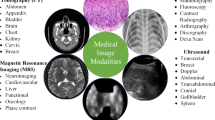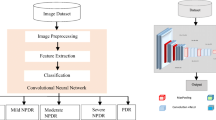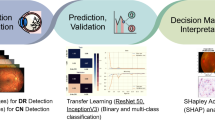Abstract
Deep learning is a useful technique for investigating the medicinal images. Glaucoma is a neurotic condition, dynamic neuro degeneration of the optic nerve, which leads visual impairment. It could be forestalled by an early detection of glaucoma and the regular screening with specialist for glaucoma diagnosis. Glaucoma is assessed by observing intra ocular pressure and optic Cup-Disc-Ratio (CDR). In this paper, novel mechanized glaucoma recognition has been performed by utilizing computer supported analysis from fundus images. The simulation outcomes are acquired by utilizing a Support Vector Machine based VGG-19 network architecture. The CDR threshold value of 0.41 has been used for glaucoma recognition. The fundus images which has the CDR greater than 0.41 is treated as glaucoma affected and less than 0.41 is non-glaucoma fundus images. The proposed glaucoma recognition system works with reasonable to obtain and generally utilized digital color fundus images. For the set of 175 fundus images a classification precision of 94% has been accomplished.






Similar content being viewed by others
References
Kolar, Radim. (2008). Detection of glaucomatous eye via color fundus images using fractal dimensions. Radio Engineering, 17(3), 109–114.
Liu et al., (2008). An automatic cup-to-disc ratio measurement system for glaucoma analysis using level-set image processing. In 13th International Conference on Biomedical Engineering (ICBME)
Walter, T., & Klein, J.-C. (2001). Segmentation of color fundus images of the human retina: detection of the optic disc and the vascular tree using morphological techniques. International Symposium Medical. Data and Analysis, 2199, 282–287.
Bock, R., Meier, J., Nyl, L. G., Hornegger, J., & Michelson, G. (2010). Glaucoma risk index: Automated glaucoma detection from color fundus images. Medical Image Analysis, 4, 471–481.
Naz, Sobia, & Rao, Sheela N. (2014). Glaucoma Detection in Color Fundus Images Using Cup to Disc Ratio. The International Journal of Engineering and Sciences, 3(6), 51–58.
Szegedy, C., Vanhoucke, V., Ioffe, S., Shlens, J., Wojna, Z. (2016). Rethinking the Inception Architecture for Computer Vision. 2016 IEEE Conference on Computer Vision and Pattern Recognition (CVPR). (pp. 2818–2826).
Joshua, O., Mabuza-Hocquet, G., and Nelwamondo, F. V. (2020). Assessment of the Cup-to-Disc ratio method for Glaucoma detection, In 2020 International SAUPEC/RobMech/PRASA Conference, (pp. 1–5), Cape Town: South Africa
Imran, Q., Muhammad, A. K., Muhammad, S., Tanzila, S., & Jun, M. (2020). Detection of glaucoma based on cup-to-disc ratio using fundus images. International Journal of Intelligent Systems Technologies and Applications, 19(1), 1–16.
Aruna Raj, P. R., George, A., (2019). FCM and Otsu ‘s Thresholding based Glaucoma Detection and its Analysis using Fundus Images. In 2019 2nd International Conference on Intelligent Computing, Instrumentation and Control Technologies (ICICICT), (pp. 753–757), Kannur, Kerala, India
Thresiamma Devasia, K., Poulose, J., & Tessamma, T. (2020). Automatic early stage glaucoma detection using cascade correlation neural network. Smart Intelligent Computing and Applications, 104, 659–669.
Law Kumar, S., Pooja, & Hitendra, G. (2020). Detection of glaucoma in retinal images based on multiobjective approach. International Journal of Applied Evolutionary Computation, 11(2), 1–13.
Abdullah, S., Jon, R., Reda, A., & Abdullah, S. (2019). Approaches for early detection of glaucoma using retinal images: a performance analysis. Data Management and Analysis, 65, 213–238.
Kavyashree, M., & Rao, P. V. (2016). A novel approach on automatic detection of optic disc and optic cup segmentation. ITSITEEE, 4(2), 2320–8945.
Kirar, B. S., & Agrawal, D. K. (2019). Computer aided diagnosis of glaucoma using discrete and empirical wavelet transform from fundus images. IETIP, 13(1), 73–82.
Zhuo Z. (2010). ORIGA-light: An Online Retinal Fundus Image Database for Glaucoma Analysis and Research. In 32ndAnnual International Conference of the IEEE EMBSBuenos
Zafer Y. (2011). Retinal Blood Vessel Segmentation Using Gabor Filter and Tophat Transform. In IEEE -19th Signal Processing and Communications Applications Conference
Geetha Ramani, R. (2017). Automatic prediction of diabetic retinopathy and glaucoma through retinal image analysis and data mining techniques. International Journal of Computer Applications, 166(8), 0975–8887.
Mohamed, N. A., Zulfikley, M. A., & Diyana, W. M. (2019). 0020”An automated glaucoma screening system using cup-to-disc ratio via simple linear iterative clustering superpixel approach. Biomedical Signal Processing and Control, 53, 101454.
Mvoulana, A., Kachouri, R., & Akil, M. (2019). Fully automated method for glaucoma screening using robust optic nerve head detection and unsupervised segmentation based cup-to-disc ratio computation in retinal fundus images. Computerized Medical Imaging and Graphics, 77, 101643.
Hsu, C.-W., & Lin, C.-J. (2002). A comparison of methods for multiclass support vector machines. IEEE Transactions on Neural Networking, 13, 415–425.
Kijsirikul, B., Ussivakul, N. (2002). Multiclass support vector machines using adaptive directed acyclic graph. In Proceedings of the 2002 International Joint Conference on Neural Networks, IJCNN ‘02. 2002. (pp. 980–985)
Author information
Authors and Affiliations
Corresponding author
Additional information
Publisher's Note
Springer Nature remains neutral with regard to jurisdictional claims in published maps and institutional affiliations.
Rights and permissions
About this article
Cite this article
Raja, J., Shanmugam, P. & Pitchai, R. An Automated Early Detection of Glaucoma using Support Vector Machine Based Visual Geometry Group 19 (VGG-19) Convolutional Neural Network. Wireless Pers Commun 118, 523–534 (2021). https://doi.org/10.1007/s11277-020-08029-z
Accepted:
Published:
Issue Date:
DOI: https://doi.org/10.1007/s11277-020-08029-z




